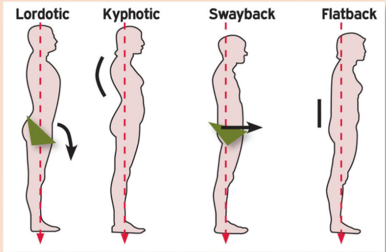Posture
Perfect Posture is Dynamic

Is there such a thing as perfect posture Florissant? The latest research shows that your perfect posture is actually dynamic, or constantly changing, not static.
Perfect Posture is Dynamic
Is there such a thing as perfect posture? The answer may surprise you.
The latest research shows that it’s actually more beneficial to think about your posture as dynamic, not static.
In other words, your ideal posture is constantly changing and evolving.
Why it Matters:
Think of your posture as a dynamic pattern of responses, reflexes, and habits - not just as a fixed position.
Gravity, your work environment, and your body's anatomy all play essential roles. For instance, sitting for hours at a time staring at a computer screen is a perfect example of a damaging static posture that over time can lead to the development of chronic forward head posture.
Forward head posture affects millions of people who spend their days using computers and has the potential to cause pain and degenerative changes in your spinal joints. It places stress on the neck and shoulders and weakens the supporting muscles.
Here’s what you need to know...
- Forward head posture affects millions and results in neck pain for up to 75% of those affected.
- Neck pain, tension, stiffness, and tenderness are all signs of chronic forward head posture.
- Trapezius strengthening has been shown to provide clinically significant relief for those struggling with neck pain as a result of forward head posture.
If you spend long hours each day in a single position - like sitting at a computer - it's important to take the time to take periodic breaks to stretch and move your body.
Remember, posture is dynamic, and stretching can help not only "reset" your posture, but also help keep your spine healthy and your energy levels up!
Scheduling a posture and movement assessment with us is also a smart idea to help ensure you remain as pain-free as possible no matter how you spend your days. Just give us a call!
How to Improve Your Posture
When discussing posture, we’re often referring to the overall position of your body as you stand, sit, or lie down.
Most experts would agree that a "good" overall posture involves physical positions that reduce stress on the body by balancing the load placed on the muscles and ligaments that support the spine.
If you've looked in the mirror and noticed that your posture doesn't look as balanced as you'd like - not to mention, doesn’t feel as balanced as you’d like - you may be wondering what you can do to improve it.
Why it Matters:
One of the best ways to improve your posture is through motion.
Changing positions frequently during the day, stretching, and specific postural exercises are all ways to improve your posture.
Good posture helps you keep your bones and joints in proper alignment, which helps reduce the wear and tear on your joints and decrease the strain on the ligaments that support your spine.
Here are some key takeaways:
- Good posture means keeping your spinal curves aligned and weight evenly distributed.
- Stretches and exercises can help improve your posture and reduce your risk of neck and back pain.
- Standing desks have been shown to reduce back pain by over 30% when compared to sitting at a desk.
When creating a plan to improve your posture, remember that stretching and exercising are essential. Equally important is knowing where to start.
Our postural and movement assessments can help you determine the best strategy to help balance and
improve your posture, especially if you’ve been living with pain.
It all starts with a phone call. We’re standing by, and ready to help!
How Your Smartphone Impacts Your Posture
Believe it or not, many of us spend 3 hours or more per day on our smartphones. That adds up to over 1,000 hours each year!
And the positions we tend to hold our heads in while using our devices can be, well... damaging. Damaging to your posture, and damaging to your spine.
It’s not surprising that over the past few years, an uptick of these awkward positions has led to an uptick in head and neck pain.
Why it Matters:
It's estimated that tilting your head forward, even just 15 degrees, can triple the weight of your head on your neck. In fact, tilting your head forward 60 degrees can increase the stress and strain on your neck ten times over.
Repeating this forward head posture again and again over time can result in pain, stiffness, dysfunction, headaches, and more - a group of symptoms often referred to as “Tech Neck.”
The good news about postural stress and “Tech Neck” is that a few simple changes to your routine can help you reduce your risk of experiencing pain.
Here’s what you need to know:
- “Tech Neck” is the term used to describe the flexed head and neck position that occurs when looking down at your smartphone.
- Just 15 degrees of forward bending can increase the stress of your head on your neck three times over.
- Taking breaks every 15 minutes and looking up from your phone or tablet can help your body reset and give your muscles a chance to relax.
Know that reducing your “Tech Neck” symptoms involves more than just changing the angle you look at your phone.
Proper ergonomics and regular stretching and exercise all play significant roles in helping you continue to enjoy your favorite devices without those nagging pains.
If you’ve been living with “Tech Neck” and are ready to take action, you’ve come to the right place!
Our expert team is ready to not only help evaluate your ergonomics, but to also provide a plan of action complete with personalized recommendations that will help make it easy for you to maintain a more balanced posture for years to come.
Posture: Balancing Strength and Flexibility
Both strength and flexibility play a significant role in how your posture develops.
For instance, having both a strong and flexible core helps the body to dynamically adapt to every environment. The spine is not only supported but also moves well, reducing the possibility of injury or pain. While it’s true that "perfect" postures may not exist, improving our strength, flexibility, and ergonomics goes a long way towards improvement.
Why it Matters:
Your body is dynamic, and it's designed to move, but over time it may feel a bit less dynamic than it used to!
Getting into a wellness routine that includes exercises that focus on strength and flexibility is a smart way to keep your body feeling young while promoting good posture - a true win-win.
Here’s why.
Strengthening exercises can help develop proper support for your joints and decrease overall postural stress. Incorporating stretches and exercise that focus on flexibility then help you body maintain the ability to move through its full range of motion.
Did you know...
- When you focus on increasing muscular flexibility, your posture is likely to improve.
- Lifting weights strengthens your back, shoulder, and core muscles, which are all essential to standing with proper posture and preventing lower back pain.
- Stretching your muscles and joints also leads to a greater range of motion, improved balance, and increased flexibility.
Remember, postural stress can add up over time. Just because you're not currently in pain doesn't mean that everything is functioning at its highest level or that your daily wellness routine is as optimized as it could be.
Our team specializes in all things posture and providing comprehensive individualized care plans - adjustments, stretches, exercises, and all!
Schedule an appointment today if you'd like to learn more about all the ways we’re helping the people in your community achieve an ideal balance of strength and posture and flexibility. Our doors are open, and we’re here for you.
: Science Sources:
Effects of Trapezius Strengthening on Posture. Med Sci Monit. 2020. Back Health and Posture. Cleveland Clinic. 2020.
"Tech Neck" Taking a Toll on Posture. Columbia Spine. 2018. Breaking up Workplace Sitting Time. Occup Environ Med. 2014. Why Being Flexible is Great for Your Health. Healthline. 2020.
Forward Head Posture and Neck Pain. Curr Rev Musculoskel Med. 2019. Guide to Good Posture. Medline Plus. 2023.
Upright Posture Improves Affect and Fatigue. J Behav Ther Exp Psychiatry. 2017. Prevalence of Forward Head Posture. IJERHS. 2019.










